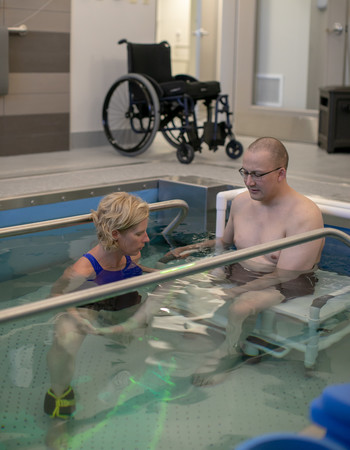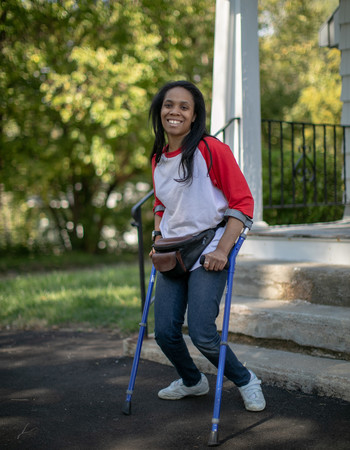




The Meaning of Care Magazine
Aquatic Therapy Offers a 'Weightless' Approach to One Heavy Diagnosis
Published: Nov. 12, 2018

- Chronic conditions
- Neurologic conditions
- Orthopedic injuries
- Balance or walking impairment
- Cancer-related conditions
The pool – also known as Heather’s Healing Pad – was funded in part by Leap-for-a-Cure, an organization spearheaded by the Roberts Family to benefit the Omaha community with brain cancer awareness, education and treatment. Although Heather Roberts lost her battle with brain cancer, she is still helping others overcome their own obstacles.
Mike Lambert, 38, has battled a diagnosis similar to Heather’s – spinal cord cancer. He’s using aquatic therapy to support a long healthy life, and he admits: Walking again would be nice, too.
The First Sign of Ependymoma
It all started in 2013. Mike and his wife were expecting their first child.
“We were getting her room ready and stuff like that,” Mike said. “I remember my foot started catching on the carpet. I would stumble and trip over things.”
An MRI showed lesions – too many to count – along his lower spine.
His diagnosis? Anaplastic ependymoma or WHO grade III ependymoma – malignant spinal cord cancer.
He underwent surgery in July 2013. The goal was for doctors to obtain a biopsy and “debulk” as much as they could from around Mike’s spine. While there were some lesions left behind, they weren’t of much concern. The surgery was successful. He received six weeks of proton radiation therapy, and by the end of the year, Mike was considered stable.
Infusion Therapy Stops Cancerous Growth
It wasn’t long before routine scans started to show growth around his spine. Mike underwent chemotherapy and more proton radiation.
Doctors also recommended infusion therapy, in which tumor-starving medication is delivered into a vein. It stopped the growth of his cancer, but it also depleted his energy level.
The silver lining came in February 2018. Doctors had seen no growth in over two years and felt comfortable taking Mike off the treatment. He was once again stable, and his energy returned.

Paralyzed but Not Defeated
Mike is a realist, but it’s clear he’s never had a shortage of optimism. He has a lot of inner strength and three giant sources of motivation – his wife of nine years, Katie, and their two little girls – Izzie, 5, and Addie, 3.
“I want to take them camping,” the proud dad said. “I want to go on hikes with them.”
While he now has the energy to do such things, the cancer robbed him of his strength and feeling from the waist down. He’s now confined to a wheelchair. Doctors don’t know whether Mike will ever walk again.
“There’s nothing saying I can,” Mike admitted. “But if there’s nothing saying I can’t, who’s to say I can’t? I want to at least try.”
Aquatic Therapy Helps Body and Mind
Mike was referred to Madonna Klein, PT, MPT, clinical coordinator of outpatient therapy services at Methodist Hospital. She oversees the Methodist Aquatic Therapy Program at Methodist Physicians Clinic HealthWest.
Klein knew right away that Mike was the perfect candidate for aquatic therapy.
“Not only does he not have to work against gravity,” Klein explained, “he gets assistance from the buoyancy when moving. So, even if he elicits a little muscle contraction, the water can take him the rest of the way.”
This is beneficial when Mike tries to mimic the motion of walking.

Julie Jessen, PT, MPT.
“It helps my brain reconnect to my feet and different parts of my legs,” he said,” “so I can remember how to make them move.”
One of Mike’s aquatic therapists, Julie Jessen, PT, MPT, is excited about the physical progress he’s made.
“It seems like every time he comes, he gains some range of motion,” Jessen said. “He gains a little bit of strength.”
But if she’s honest, the mental progress he’s making is even more exciting.
“Being able to come to the pool and do the things he can’t do on land improves his mood,” Jessen said. “It also improves his sense of independence.”
Progress on Land
Mike’s work outside the pool is most telling of how far he’s come.

Klein was working with him in the gym – guiding him to contract his thigh and lift his leg off a bolster. They had attempted similar movements in the past.
After a couple of hard-fought tries, he succeeded. He kicked his leg off that bolster.
“The amount of improvement over just a couple weeks in the pool was astounding,” Mike said as he choked back tears. “Like – emotionally astounding. Because I hadn’t moved that way in so long!”
And during a more recent gym session, Mike was able to power himself up into a standing position as Klein locked out his knees.
“He has not been able to do that since he lost the use of his legs,” Klein said. “It’s just incredible.”
Not Just for Cancer Patients
While aquatic therapy has shown promising results in people suffering from cancer-related conditions, it doesn’t end there. So many people are benefitting from this “weightlessness” in the water.

13 months old.
“Basically, you feel trapped in your own body,” she said.
When Anna turned 30, she said, her body took a turn for the worse. She grew stiffer and weaker. Every move she made was challenging and exhausting.
When she walked into her first aquatic therapy session at Methodist – she immediately noticed the warm and welcoming atmosphere. That alone was healing, she said.
After just 22 sessions, Anna noticed a substantial difference – not only in how freely she could move, but how free she felt.
“When you can’t move the way you want to move – the way you know you can move, it’s frustrating,” she said. “I was really depressed. Being in the water took that away. Especially when I saw the difference on land.”

Recently, Anna started land-based therapy, which has been very successful.
“There’s no way I could do what I’m doing if it wasn’t for Julie and that pool,” Anna said.
More Than Therapy, More Than a Goal
Anna’s story is similar to Mike’s. Both have unique conditions. Both have seen astonishing results. Both admit that what they found at Methodist has been unlike the rest of their care – it’s not one-size-fits-all. It’s individualized. It’s strategic.
“And I just don’t think you get that at other places,” Mike said.
And perhaps even more therapeutic than that patient-centered approach are those who provide it.
“It’s not about the tools in the gym. It’s not about the great new table I get to sit on. It’s about the people.”
Mike Lambert
Aquatic therapy patient
While Mike is determined to see the world from six feet high again, this journey has taught him to value the time he’s given – to do more with his life and the people he loves.

“If I never walk again, fine,” Mike said. “I just want to be there for my kids. That’s pretty much it. And my wife and I – we’ve got plans. We’re not going to let this stop us. So, I choose to decide that I’m going to do it – that I’m going to live my life.”


